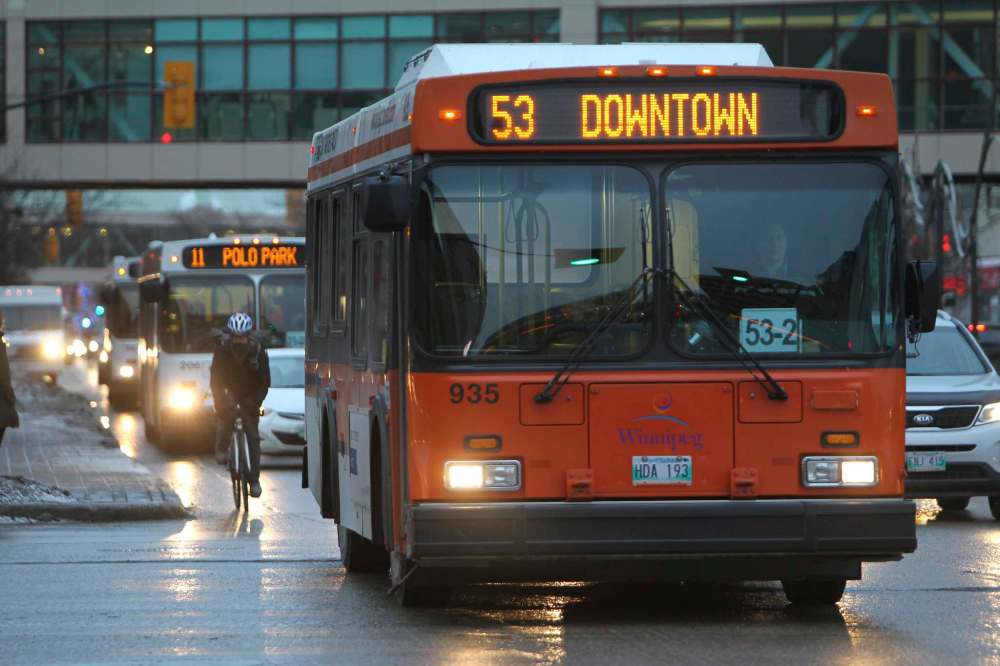Transit identifies routes targeted for reduction
Advertisement
Read this article for free:
or
Already have an account? Log in here »
To continue reading, please subscribe:
Monthly Digital Subscription
$0 for the first 4 weeks*
- Enjoy unlimited reading on winnipegfreepress.com
- Read the E-Edition, our digital replica newspaper
- Access News Break, our award-winning app
- Play interactive puzzles
*No charge for 4 weeks then price increases to the regular rate of $19.00 plus GST every four weeks. Offer available to new and qualified returning subscribers only. Cancel any time.
Monthly Digital Subscription
$4.75/week*
- Enjoy unlimited reading on winnipegfreepress.com
- Read the E-Edition, our digital replica newspaper
- Access News Break, our award-winning app
- Play interactive puzzles
*Billed as $19 plus GST every four weeks. Cancel any time.
To continue reading, please subscribe:
Add Free Press access to your Brandon Sun subscription for only an additional
$1 for the first 4 weeks*
*Your next subscription payment will increase by $1.00 and you will be charged $16.99 plus GST for four weeks. After four weeks, your payment will increase to $23.99 plus GST every four weeks.
Read unlimited articles for free today:
or
Already have an account? Log in here »
Hey there, time traveller!
This article was published 01/12/2017 (2925 days ago), so information in it may no longer be current.
Winnipeg Transit expects to save $1 million by reducing service on a possible 22 low-ridership routes.
Transit officials identified the 22 routes ahead of the department’s budget presentation Friday to councillors on the public works committee.
Coun. Marty Morantz, chairman of the the committee, repeated city hall’s position that the looming cuts, along with a 25-cent fare increase, were the result of the Pallister government’s unilateral decision to end its 50-50 transit funding agreement.

“These measures are difficult decisions to make,” Morantz (Charleswood-Tuxedo-Whyte Ridge) told reporters. “We’ve had to make hard decision in many, many areas. The decisions around transit are essentially as a result of the unilateral ending of the 50-50 funding transit agreement. We’ve dealt with it the best way we can.”
The reduction in service was prompted by a $10-million shortfall in anticipated funding from the provincial government.
The preliminary city budget proposes a 25-cent fare increase to raise $5.68 million, with the reduction in routes services generating another $1 million in savings.
Transit is proposing a $192.5 million budget for 2018, an increase of $1.2 million from 2017.
Transit officials said the list of 22 routes is subject to review and could change before the cuts are implemented in June.
Transit plans to reduce the frequency of some routes with the lowest ridership only during the least busiest of times: mid-morning, early afternoons, and late evenings, on weekends.
Officials said the reductions will not occur on those routes when ridership is at a maximum or there are pass-ups — situations when buses skip a stop because it’s full and can’t accommodate any additional passengers.
To support Morantz’s contention the province is to blame for cuts to Transit, officials said that the provincial government’s share of transit’s revenues is shrinking from 26 per cent this year to 22 per cent in 2018.
Earlier at the committee, Couns. Janice Lukes and Cindy Gilroy urged the committee to establish a discount fare for low-income earners.
Lukes questioned why Transit had chosen to reduce route service, pointing out it’s going to generate only a small savings and believed the dollars can be found elsewhere in the city’s overall $1-billion budget.
Morantz continued to defend Transit’s decision to spend $300,000 on a Wi-fi pilot project, describing it as a worthwhile initiative for long-term improvements to transit for safety and its fare infrastructure system.
The funding for the Wi-Fi initiative is not coming out of transit’s budget, but being provided by a special innovation fund designed to support projects that typically have a low priority in a department budget but have the potential to save costs, generate revenue and improve the delivery of service.
Officials were unable to provide the committee with ridership numbers on the 22 routes, except for one: DART 110, where it average only 1 rider daily between 6 a.m. and 11 a.m. on Saturdays.
aldo.santin@freepress.mb.ca
History
Updated on Friday, December 1, 2017 3:19 PM CST: Updated

